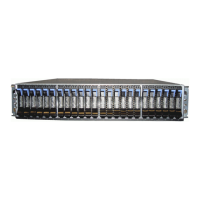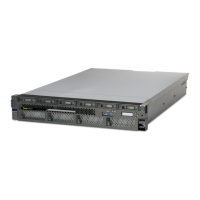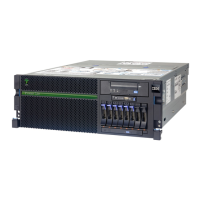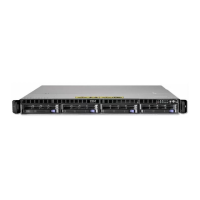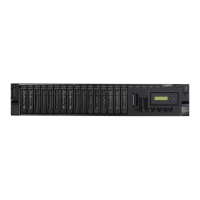Chapter 1. General description 5
Draft Document for Review May 22, 2009 3:10 pm 4405ch01 General description.fm
6 PCI slots per enclosure: 4 PCIe, 2 PCI-X; 24 PCI per system: 16 PCIe, 8 PCI-X.
Up to 2 GX+ adapters per enclosure; 8 per system
One hot-plug slim-line media bay per enclosure, 4 max per system.
The external processor fabric bus in this system is modular. For a multiple-drawer server
configuration, a processor fabric cable or cables, and a service interface cable are required.
Cable features are available for connecting pairs of drawers, three drawer stacks, and four
drawer stacks. With this modular approach, a separate cable is required to connect each
drawer to each other drawer in a multi-enclosure stack (See 2.2.1 and 2.4.2).
The service processor (SP), which is described in 2.14.1, “Service processor” on page 70.
Each system includes the following native ports:
Choice of integrated (IVE) I/O options -- one per enclosure.
– 2-port 1 Gigabit Integrated Virtual Ethernet controller with two system ports
(10/100/1000 twisted pair).
– 4-port 1 Gigabit Integrated Virtual Ethernet controller with one system port
(10/100/1000 twisted pair).
– 2-port 10 Gigabit Integrated Virtual Ethernet controller (SR optical) with one system
port.
Two USB ports per enclosure.
Two system (serial) ports per enclosure. Only the ports in the base enclosure are active,
and only when an HMC is not attached.
Two HMC ports per enclosure. The HMC must be attached to CEC enclosure 1 (and CEC
enclosure 2 to support redundant Service Processors).
Two SPCN ports per enclosure.
In addition, each building block features one internal SAS controller, redundant
hot-swappable cooling fans, redundant power supplies, and redundant processor voltage
regulators.
1.3.1 Processor card features
Each of the four system enclosures has two processor sockets and can contain two
POWER6/POWER6+ dual-core 64-bit processor card features, or two POWER6 dual-core
dual-chip processor card features. They are configured as dual cores on a single chip module
or dual chip module with 32 MB of L3 cache, 8 MB of L2 cache, and 12 DDR2 memory DIMM
slots.
The POWER6 processor is available at frequencies of 3.5, 4.2, or 4.7 GHz. The POWER6+
processor is available at frequencies of 4.2, 4.4, and 5.0 GHz.Each system must have a
minimum of two active processors. A system with one enclosure may have one or two
processor cards installed. A system with two, three, or four enclosures must have two
processor cards in each enclosure. When two or more processor cards are installed in a
system, all cards must have the same feature number.
All processor card features are available only as Capacity on Demand (CoD). The initial order
of the system must contain the feature code (FC) related to the desired processor card, and it
must contain the processor activation feature code. The types of CoD supported are:
Capacity Upgrade on Demand (CUoD) allows you to purchase additional permanent
processor or memory capacity and dynamically activate them when needed.

